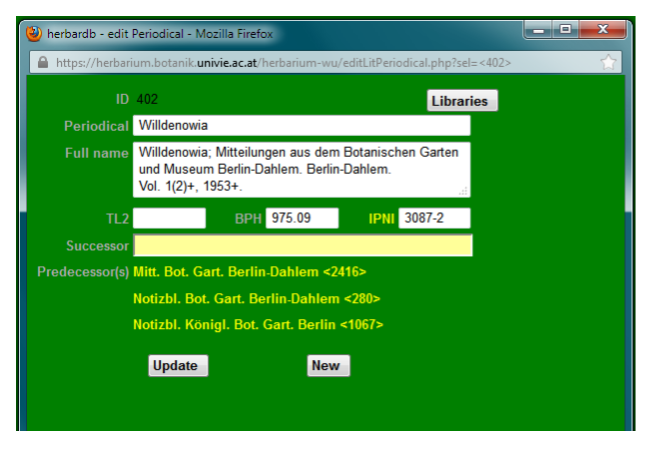Table of Contents
Literature
The Literature form
Clicking on the Literature button opens a search window for literature references. As an example, open the record “Flora Orientalis” by Boissier. by typing „fl. orient“ in the field Periodical. You get a list of all the volumes under this title (in this case all the volumes are already entered into the database). There are seven volumes (1, 2, 3, 4(1), 4(2), 5(1), 5(2) and Supplement) published between 1867 and 1888, furthermore the volumes 1-5 were published by Boissier, the Supplement by Buser.
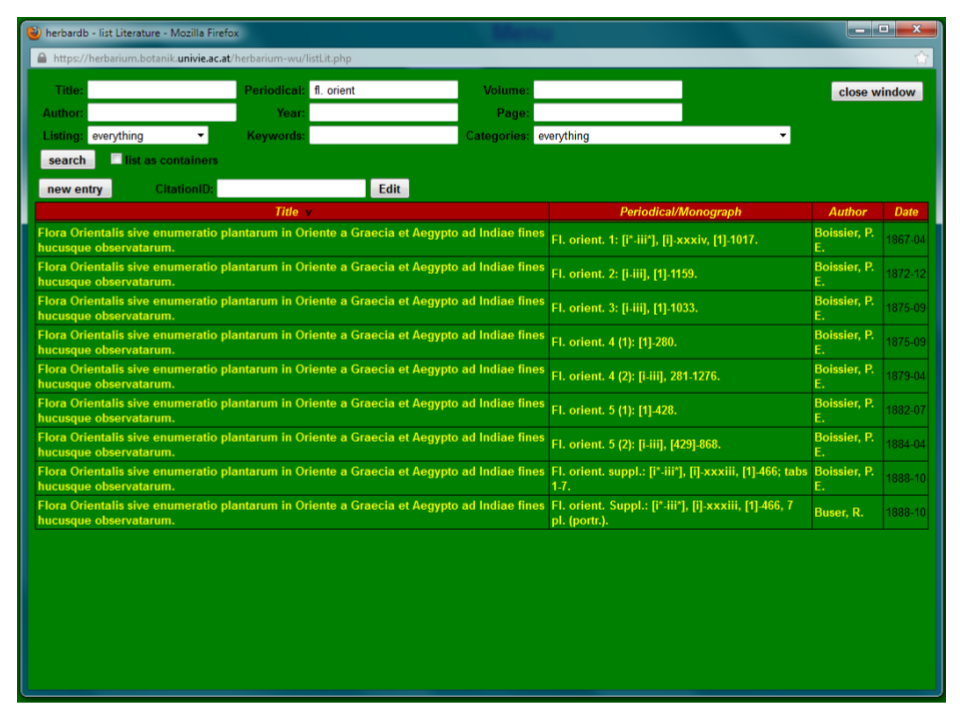
Click on the first volume to enter the record.
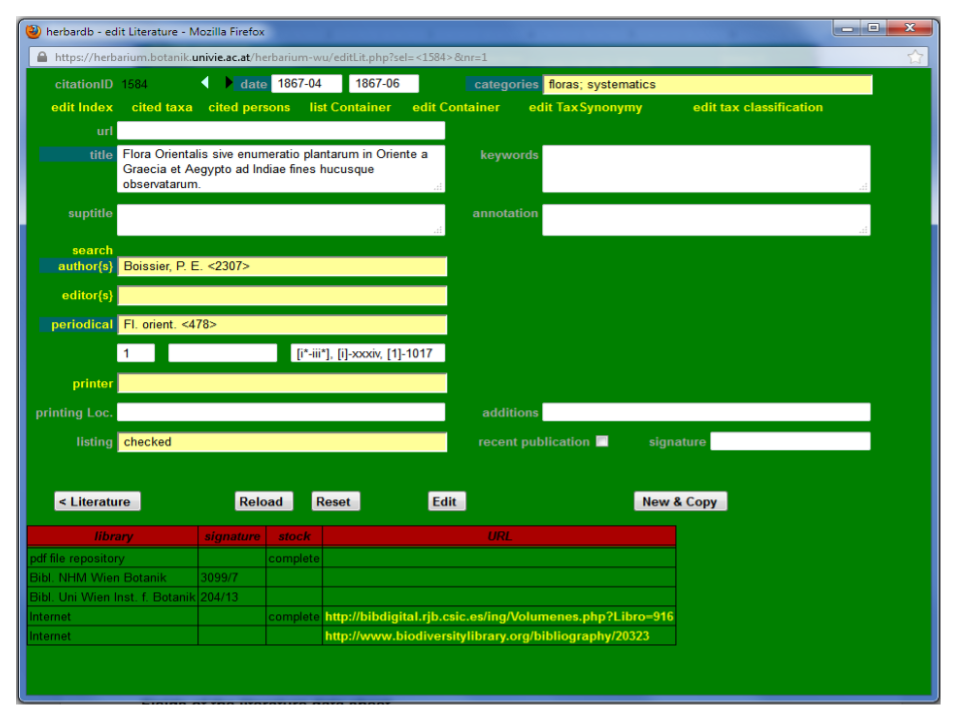
Fields of the literature data sheet
Going through the data fields from left to right, top to bottom:
| CITATION ID | Every literature record has its own ID number. |
| < > | The two arrows allow you to scroll through your search results. |
| DATE* | Date of publication. Written as: YYYY-MM-DD (or just YYYY-MM, YYYY). For references published over a period of time, the start and end date are entered in the 2 fields, respectively. |
| CATEGORIES* | Indication of the kind of literature (e.g. biography). Chosen from the drop-down menu. Most literature is listed as “floras, systematics” (in rare cases “biography”, “history”, “herbaria” etc. are used). |
| EDIT INDEX | List of newly described taxa. |
| CITED TAXA | List of mentioned taxa of special interest. |
| CITED PERSONS | List of mentioned persons of special interest. |
| LIST CONTAINER | Shows structure within complex literature (e.g. chapters). |
| EDIT CONTAINER | Enables to edit this structure. |
| URL | Link to publication online. Insert the web link or, if available, the DOI number (note 1). |
| TITLE* | Full title. This can be the title of a chapter, volume, monograph, etc. It is free text and ended with a full stop [.]. Do not abbreviate. |
| KEYWORDS | Describing the publication. |
| SUPTITLE | “super title” Cannot be inserted/edited any more; will be removed shortly. |
| ANNOTATION | Further annotations. Free text on anything to be noted. |
| AUTHOR{S}* | Chosen from the drop-down list. All (!) authors should be added in the order given in the literature itself or in a database. e.g. The “Flora of China”: each volume is edited by an editorial committee and composed of several chapters, written by different authors. Thus, the volumes themselves are inserted with the editors as AUTHORS, whereas the single chapters (genera or families) are entered as separate records with the respective authors. The chapter records can then be linked to the volume records by means of Edit Container. You can choose “unclear” if the authorship of the publication isn't evident or “Anonymous” if no name(s) are given. In the database, authors are given as: “Boissier, P. E.” for Pierre Edmond Boissier. If the forenames are unknown or unclear, only the name is listed. Names with “MC” or “Mac” are written as “McNeill, J.” Titles of nobility are inserted like “Wettstein, R. von”. Pay attention to the correct form of the double family name, e. g. “Fuente García, V. de la, Sánchez-Mata, D. & Moreno Saiz, J. C”. Multiple authors are combined with “&” and/or a comma i.e. “Schiffner, V. & Arnell, S. W.” or “Huter, R., Porta, P. & Rigo, G.” |
| EDITOR{S} | cannot be used any more, will be removed shortly. |
| PERIODICAL* | Periodical (note 4) or monograph (note 5) in standard abbreviation. Publications are chosen from the drop-down menu. They are listed in the database in standard abbreviation according to TL2,BPH or IPNI. Note that in this database the field PERIODICAL is used for both periodicals4 and monographs5 (special case: theses (note 6)) |
| UNNAMED (LEFT) | Volume, part etc. Volume number (in Arabic numerals or text i.e.“Supplement”). |
| UNNAMED (MIDDLE) | Subdivisions (also in Arabic numerals and/or text). |
| UNNAMED (RIGHT) | Pages, figures and tabulae. The range of pages. Essentially, the pages as noted in the book (in Arabic numerals). If the first page number(s) are not printed, but followed by printed numbers, this is indicated by [ ], i.e. [1]-278 or [1-3]-278 (with the first three pages unnumbered). If there is a preface with extra pagination, this is also indicated, i.e. “1-7, 1-278” or “i-vii, 1-278” (depending on whether these numbers are given in Arabic or Roman numerals.) In case the preface does not have any extra pagination or just a part of it, this is indicated by [ ], i.e. “[i-iii], 1-278” or [i-xv]-xxx, [1]-253. If there are several prefaces with extra pagination and extra symbols, this is also indicated (see the example below). Figures (note 2) and tabulae (note 3) are listed after the pagination with their abbreviations “fig.” and “tab.” (plural “figs.” & “tabs.”), separated by a comma. If the figures/tabulae are numbered this is indicated by “figs. 1-15”, otherwise the total number is indicated as “3 figs.”. Example: In more complicated cases, the complete pagination might look like this: “[i-iii], [i]-xxxiv, [1]-1017, 7 figs., tabs. 1-5” which means: (i) a first preface of unnumbered pages (ii) a second preface of numbered pages, with the first page unnumbered (iii) 7 figures without numbering (iv) 5 numerated tabulae. |
| PRINTER | Printer/publisher from the drop-down list, as indicated in the literature itself or in databases. |
| PRINTING LOC. | Printing locality. Free text, as given in the literature itself or in a database. |
| ADDITIONS | Further additions. |
| LISTING | Indicates whether the information has been checked on the basis of the original literature or is taken from other sources. Chosen from a drop-down list. Common options are: * CHECKED: the original literature has been seen. (NB: In this case the fields URL and/or SIGNATURE should be filled in as well) * DESIDERATUM: literature was inserted based on data from databases, but could not be checked. Desideratum indicates that this literature would be of interest and should be looked for. * OPEN: all the data inserted has been derived from databases or the herbarium specimen but the original publication could not be checked. * REPRINT: a reprint from the original literature was available and could be checked. This is additionally indicated in the reprint´s pagination or date which might differ from the original. |
| RECENT PUBLICATION | Tick box if applies. |
| SIGNATURE | Library reference number. |
| < LITERATURE | to return back to the search page |
| RELOAD | Makes saved changes in the form visible |
| RESET | Return to the original status of the record (only if the record has not been updated in the mean time). |
| EDIT | Make changes to an existing record. |
| INSERT | Insert a new record. |
| NEW© | Use an existing record as template for a new entry. |
| INSERT© | Make a new record based on the previous entry. |
| INSERT&NEW | Make a new record from a blank form. |
| LIBRARY | Information about availability of the reference in libraries, pdf collection, internet sources. |
* fields with an asterisk are mandatory
Working in the DB
Searching
Some recommendations to optimize searches:
A general search query using only the field Periodical for the name of an important journal will yield dozens of entries, making it necessary to refine the search terms.
In the case of monographs with a single or few volumes it is specific enough to search for the name in Periodical (note that in this database the field Periodical is used for both periodicals and monographs.).
PERIODICAL:
Following the example “Flora orientalis” by Boissier. First start with a general request.
Type in “flora orientalis” in Periodical. No results are shown because in the field Periodical you can only search for the standard abbreviations (see also: Sources of information).
The standard abbreviation for the “Flora orientalis” by Boissier is “Fl. orient.”, so type this in Periodical and you will get all volumes listed. It is sufficient to type in “fl. or” or “orien”. You do not need to type the entire title (but do not forget the full stops and spaces within).
TITLE:
Here, you cannot search using standard abbreviations, only the original wording of the title. It is also possible to search using fragments of the title, like “flora or” or “orien” to get a result.
AUTHOR:
Generally you only search using the surname. It is not necessary to write the whole name. Note that the author may change during the publication period or among volumes. In the example of Flora orientalis searching for “Boissier” will only display volumes 1-5, because the Supplementum was written by Buser.
If you search for “Boissier” without any other search terms (Year, Periodical etc.) you will get dozens of entries. Refine the search query by filling in a combination of different fields.
VOLUME:
This is useful for refining a general search query in a Periodical with many databased volumes.
Please Note: In contrast to the other fields it is not possible to search for pieces of the volume number. If you search for “1”, you only get volume 1. If you use the wildcard-character ”%” i.e. you search for “1%”, you get volumes like 1, 17, 113 and also 113a.
YEAR:
To search for the publication date. If you search for a date in the format YYYY-MM-DD, which is entered just with the publication year, you will obtain no results. It is also possible to leave last digits out. If you know the decade of publication, but not the exact year i.e. for literature from the 1880s search for “188”.
TROUBLESHOOTING
Some reasons why you may not find the literature you are looking for, even though it is in the database:
| “typification” | Some citations are inserted as rudimentary records because the original literature was not available. For example only the Periodical, Author and the Year were inserted, whereas the title was unclear. Instead these fragments are therefore entitled “typification”. In most cases, the pagination of these entries is reduced to a single page. If you have the original literature, check whether this page lies within the range of pages. In most cases, these typification entries were created because a taxon was originally described there. In most cases you will find a taxon entry with a given page if you click Edit Index. If this description is part of your publication you can be certain that you are in the right record.) In some cases the author(s) of the newly described taxon entered in the field Author is not the same as the one who actually published the paper. “typification” entries are provisional! If you have the original literature, edit the record and fill in all the missing data. |
| looking for the wrong year | Often later volumes of a given year were published the following year. This leads to situations like a publication date of 1859 for an August volume of 1858. Publications spanning over long time periods can be also problematic. In the field Year you can only search for the beginning of this period (i.e. if the publication date for you reference is 1850-1851; searching for 1851 will not bring up the record) In both cases it might help to leave out the last digit and broaden the search. |
| looking for the wrong “periodical” title | Some periodicals may change their titles over time, for example: 1895-1915: Notizblatt des Königlichen Botanischen Gartens und Museums zu Berlin (-Dahlem). Vols. 1-6 1916-55: Notizblatt des Botanischen Gartens und Museums zu Berlin-Dahlem. Berlin-Dahlem. Vols. 7-15 1953: Mitteilungen aus dem Botanischen Garten und Museum Berlin-Dahlem. Berlin-Dahlem. Vol. 1(1) 1953+: Willdenowia; Mitteilungen aus dem Botanischen Garten und Museum Berlin-Dahlem. Berlin-Dahlem. Vol. 1(2) or Feddes Repert. Spec. Nov. Regni Veg. (Vols. 52-69, 1943-1964) with its successor Feddes Repert. (Vols. 70+, 1965+) and its Predecessor(s) Repert. Spec. Nov. Regni Veg. (Vols. 1-51, 1905-1942) |
| Incorrect spelling | In rare cases authors or standard abbreviations of literature may have been entered incorrectly in the database. In other cases alternative spellings have been used, e.g. Boris Stefanov instead of the standardized spelling Boris Stefanoff linked to IPNI. Some journals have two names in different languages. For most of them, there is one standard abbreviation listed in BPH. Sometimes an abbreviation of the name in a second language also exists. Check for alternative names in BPH. Make sure that the fields LISTING and CATEGORIES are set on “everything“ for a general search. |
Entering new data
After being sure that the literature is not already databased (including an incomplete version as “typification”), there are two principal ways to create new entries:
- start with a blank form or
- use a similar, existing entry as a template
NEW ENTRY
By clicking on this field on the search page, a blank sheet (without ID) opens. You can now fill in the data according to the aforementioned formats. Fields that are highlighted against a blue background are obligatory. When finished, press Insert to save the record. As a result, a new ID appears in top left corner.
NEW & COPY
In many cases it is useful to take a similar existing entry as a template for a new entry, i.e. when several volumes of a series have been published.
Open it and click New & Copy. This will open a new form, with all the data of the original entry. Change the relevant fields (like the title, author, publication date etc.) according to your needs, then click Insert.
This will generate a new record (with a new ID), while the original remains unchanged.
INSERT & COPY
By clicking this button, the current record is inserted into the database and a new record is opened, with the fields filled as in the one you just saved. You can now make the relevant changes and insert it as a new entry.
INSERT & NEW
By clicking this field the record is inserted and a blank sheet opens.
Editing data
This option is used to amend existing entries. By clicking Edit the edit mode opens. Now work on the form and click Update to save your changes. Please Note: By clicking Literature you can leave your form without saving your changes or inserting new records. Your changes are only saved after clicking Insert or Update. Just pressing Edit does not save anything! After editing a record check again the changes you made in it. It is also advisable to look again for it from the list Literature window.
Entering new data in the drop down fields
Drop-down lists are found in the fields Categories, Authors, Periodical, Printer and Listing. It may occur that you do not find the entries you need in the list. Searching in the drop-down list is different from the literature search page. Note that it is not enough to type in a single letter in the drop-down menu. You need at least two letters or one letter and the wildcard %. Furthermore, it is only possible to search starting with the beginning of the words.
Example:
The “Österreichische Botanische Zeitschrift” is recorded as “Österr. Bot. Z.”, which is the standard abbreviation. As the database also contains the complete title, searching for “österreichische” or “botan” will also lead you to the relevant entry.
Always check thoroughly whether a record really exists before creating a new one. Avoid double entries!
By clicking the Authors, Periodical or Printer buttons, a small window opens. If necessary you might add details or make changes to an existing record. After editing click Update.
If you want to insert a new record in one of these fields, click on the field button you need and use the button New to open an empty data entry sheet.
AUTHORS:
Type the standardized name in Author. Referring to IPNI - AUTHORS. Fill in the full name, the date of birth and death (and if necessary other data) in Autorsystbot. This only applies for single authors, not for author combinations (Autorsystbot is left empty in the latter case). For information on authors see sources of information.
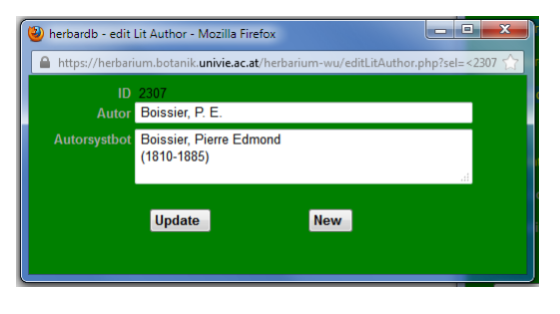
PERIODICAL:
Fill in the standard abbreviation of the publiction here.
In Full Name add the full title, but also dates of publication, data on volumes, printing locality etc.
In TL2, BPH & IPNI fill in the relevant catalogue numbers (see sources of information).
Successor: publication titles may change over time. Choose the new publication name in the drop-down list (listed by standard abbreviation).
Predecessor(s): is generated automatically, if the previous “periodical” is linked with the successor.
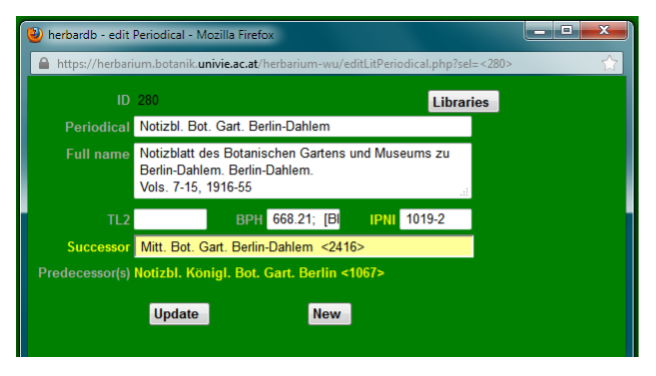
LIBRARIES:
Found in the top right corner, to record where to find a given reference, i.e. in a library or from an internet source.
Clicking on this field will open a list, which might already contain some entries.
Clicking Add New Line opens a blank sheet, where you can choose a library (or internet source) from the drop-down menu; fill in the signature (library reference number); add a URL; add Stock (volumes available).
By clicking Insert the data is saved, using Cancel you leave the page without saving any changes.
To change existing entries click Edit and save the changes by clicking Update. Click Reload to make the changes visible on the Edit Literature page.
Structure of literature
In the simplest case, a work is written by a single author and published as a stand-alone publication. More often, there may be different chapters (e.g. family treatments) or parts published by different authors or at different dates, which makes a separation necessary. The same is to be done with works published in several volumes.
Be aware that small chapters within larger publications are sometimes written by different authors and should be treated as separate entities.
In the past, many books were published in sections and sent in unbound versions to recipients by the printing companies. As soon as a volume or a part of it was complete, it was brought to a local bookbinder. They had, in certain respects, different possibilities to arrange the pages. Sometimes illustrations were placed at the end of the book or within the text; the title pages were sometimes completely removed and discarded. Different books might therefore have a different sequence and your book may be different from descriptions in literature databases.
In case of removed title pages, you have to try to seek this information from other sources (e.g. TL2). There can be inconspicuous indications on the publication dates of the different parts. Knowing that title pages were often discarded, the publishers in many cases wrote extra notes at the bottom or the top of the text pages regarding the publication dates. As an alternative, you might find the publication dates of the different parts listed at the beginning or the end of a book.
Note that one work can be split abruptly into two or more continued fractions linked to different publication dates, and as a result, even one newly described taxon in this work might be linked to two different dates.
Complex literature is organized in several levels of hierarchy, like the “Flora Iranica”, which comprises several volumes which are furthermore divided into different taxonomic treatments, often containing chapters by different authors.
How to document this structure
Before you start, always make sure that you really understand the whole structure of your reference. The smallest entities are mainly chapters or even parts of them by a given author. If these are split over different publication dates you have to insert them separately. These entities are the most important ones, as all the taxa descriptions are linked to them. To display them within the context of the whole publication, you also have to add the higher hierarchy levels to the database.
For example:
“Botanische Reisen in den Hochgebirgen Chinas und Ost-Tibets.” by W. Limpricht is a report on an excursion by Limpricht, published in the 12th volume of the Repert. Spec. Nov. Regni Veg. Beih. in 1922.
This report is divided into two main parts:
“I. Botanische Reisen in den Hochgebirgen Chinas und Ost-Tibets.” by Limpricht.
“II. Aufzählung der von Dr. Limpricht in Ostasien gesammelten Pflanzen” by Pax.
The second part itself is composed of family treatments by different authors, i.e. “Asclepidiaceae” by Schlechter or “Symplocaceae” by Lingelsheim & Winkler. These family treatments are the above mentioned smallest entities, which contain descriptions of new species.
This should look like the following:
- Botanische Reisen in den Hochgebirgen Chinas und Ost-Tibets - Limpricht
- I. Botanische Reisen in den Hochgebirgen Chinas und Ost-Tibets - Limpricht
- II. Aufzählung der von Dr. Limpricht in Ostasien gesammelten Pflanzen – Pax
- Asclepidiace – Schlechter
- Symplocaceae - Lingelsheim & Winkler
All these different hierarchical levels have to be documented and then linked. In our database these hierarchical levels are called containers, as they can contain other pieces of literature.
Linking is done by using the option Edit Container. This opens a form in which you can insert the next higher container (=next higher hierarchical level).
At the top of the window you see the literature you are working on; below there is a blank line (if it is still unlinked!).
Set a check mark in the small field on the left and then search for the next higher container in the blank field. In most cases it is sufficient to type in one of the authors and the year of publication. You then get one or several results in the drop-down menu. Choose the right one (according to title, pagination etc.) by clicking on it. Then confirm with Update.
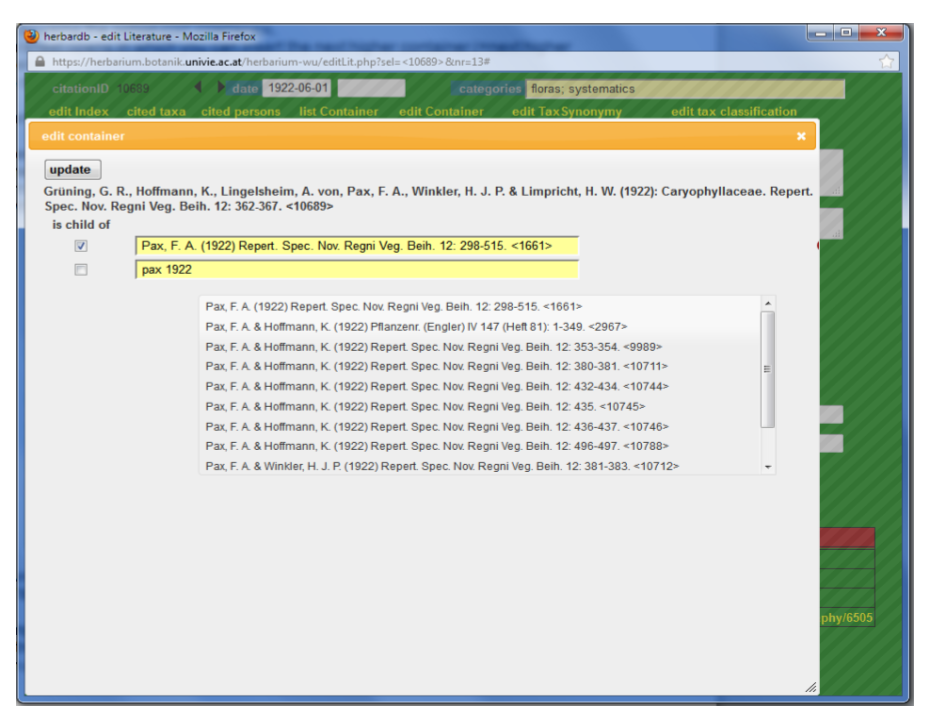
The Edit Container option can also be used to delete erroneous entries by clicking on the white cross in a red circle (“delete entry”).
To view the complete structure of a reference, click List Container. You will get a tree, showing all the linked (!) entries at different hierarchical orders. By directing the curser arrow to an entry an extra box with all the full reference pops up, which will take you to the corresponding record if you click it.
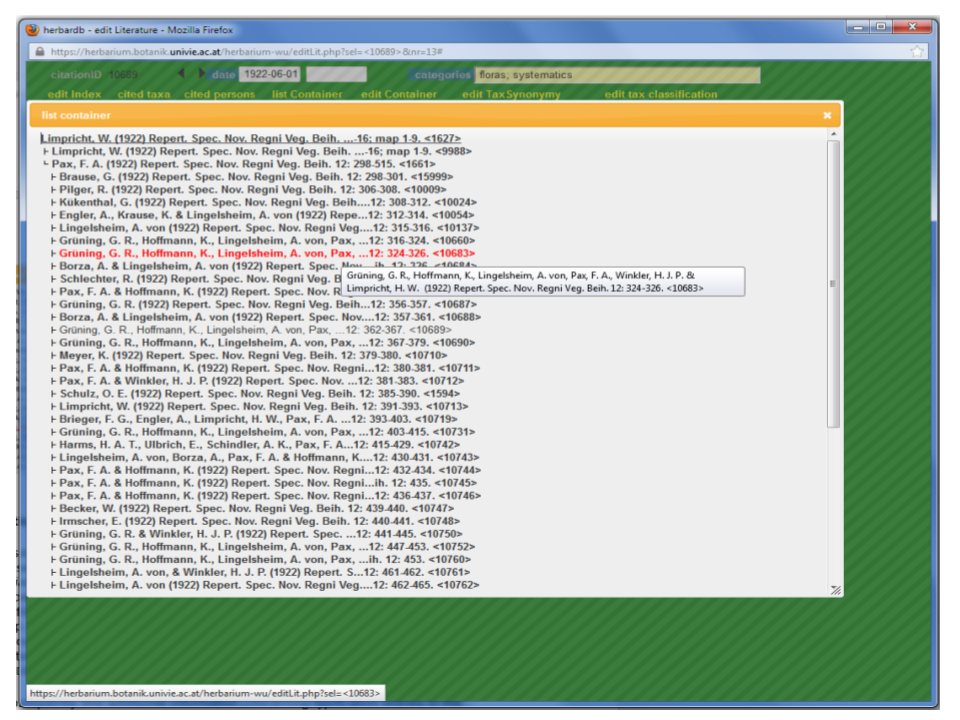
"typification"-entries
They are set up for literature that is not available, e.g. if you know that Wood published Didiplis diandra on page 124 of “Amer. Bot. Fl.” but you cannot check the title and the range of pages; you still need to insert the citation in order to print a label.
Therefore, you fill in as much as you know. This will probably include the publication year, authorship, periodical and the page where the taxon is described.
As Title you enter “typification.” and set the Listing to “open”. After inserting the record you can link the taxon via Edit Index.
If you subsequently find additional information concerning “typification” entries in the database, please complete the entry.
schedae-publications
Up until January 1st, 1953, schedae [scheda, also scida (pl. schedae), latin for “papyrus strip”, “tag” or “sheet”] were a valid form of publication. They were validly published as long as they contained a diagnosis or description, were reproduced mechanically or graphically and were distributed according to the ICN. After this date, they were only validly published if also distributed independently of the exsiccatae (e.g. as a paper in a journal or a fascicle).
Schedae publications once were common, especially in the form of series. These were distributed with labels for all the specimens and new taxa were described directly on them (e.g. the series “Flora exsiccata Austro-Hungarica” by Kerner, which contains many descriptions in schedae).
There are many different forms of publications in schedae. The simplest case is a collection of a single taxon with reproduced labels including a description. They can also be part of an often numbered series. Sometimes, labels were also published as a separate booklet (with pagination). The way to treat these in the database differs from case to case, so always check TL2 for further information.
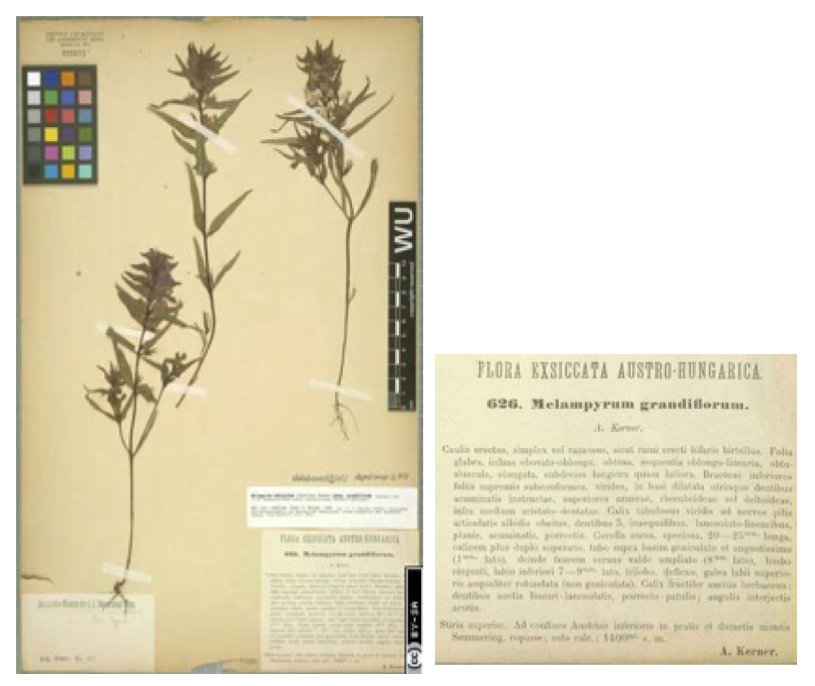
How to enter a schedae-publication
For a single taxon, the fields are filled in as follows:
Date: as indicated on the label
Categories: floras, systematics
Title: taxon name
Author(s): as indicated on the label
Periodical: “in schedis lithogr.”
Unnamed Fields: in case, there is a number given, enter it in the third field
Listing: “checked”
Then go to Edit Index and link the entry to the corresponding taxon.
In the case of serials, they mainly have a title such as “Schedae ad floram exsiccatam austro-hungaricam” or “Schedae ad Floram Italicam Exsiccatam”. The full title should be entered in the field Title; in Periodical the abbreviated title should be entered (e.g.” Sched. fl. exs. austro-hung.”). For abbreviations check our database IPNI or TL2.
In most cases the editor is given as AUTHOR, but taxa within the series can be described by other people. Series are generally numbered, so indicate this as well. Some serials are organized and distributed in centuriae or other divisions, e.g. the “Herb. Norm. Sched.”. This structure is also documented in the database.
The centuria (latin for a division of a hundred) number is given on the left of the unnamed fields. In principle, this field is restricted to numerals. Hence, “Cent.” is suffixed after the series abbreviation, in this case “Herb. Norm. Sched. Cent.”, the number of the centuria is entered in the left and the range of numbers in the right field.
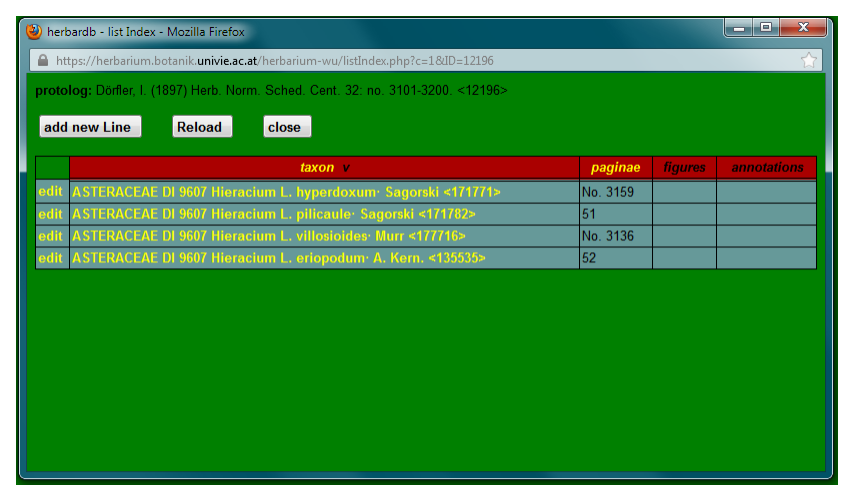
Depending on the information available, document the schedae-number and/or the page number(s) of the bound version of the schedae in the Edit Index sheet.
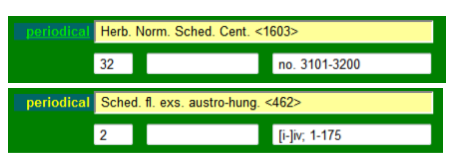
Miscellaneous sections in publications
In some cases species are published in a section of a publication that groups together miscellaneous information (i.e. a list of events during the year including new species found, conference summaries, new books published etc.). These can be grouped in a notes, news or miscellaneous section of the journal. In the database, the section is treated as a whole and entered under the name of the section with authors as “Varii”. You then enter a new entry with the author of the section where the species is published and fill in the rest of the data entry sheet as usual. You then must click Edit Container, select the section where this comes from in the drop down menu and tick the box; to show that your entry is part of the wider section under “Varii” as author.
Example:
“Smärre notiser. Lärda sällskaps sammanträden.” in Bot. Not. 1883: 62-79. (A list of notes concerning different botanists and events for the year 1883.)
Within these notes there is a list of mosses published by S. O. Lindberg which was relevant to the specimen being entered. Therefore, one entry was made that encompasses “Smärre notiser. Lärda sällskaps sammanträden.” Bot. Not. 1883: 62-79 under Author: “Varii”. A second was made for S. O. Lindberg´s section Bot. Not. 1883: 63-63 and this entry was linked to the “Varii” entry. The specimen can therefore be entered using S. O. Lindberg´s citation in the journal.
How to link taxon names with the relevant literature
Literature records can be linked with taxa, using Edit Index or Cited Taxa. By clicking on these fields a new window with a table opens in which taxa can be added (Add New Line), with the relevant pages and figures/tabulae.
Existing entries can be edited via Edit.
For further information see this chapter in the Taxonomy manual.
Sources of Information
Extra information can be found within the publication itself. On the first and last pages there are often indications as to whether a book was published in parts or not with the respective dates and other valuable hints. In journals, where several issues are often bound together, go to the first pages of an issue to find more detailed information on publication dates or issue numbers.
Additionally there are several databases which should always be consulted. There, you can find information on standard abbreviations, publication dates, publication history, changing editors, inner structure etc.
The most relevant databases are:
The Botanico-Periodicum-Huntianum
Link: BPH
This internet database is based on the printed volumes of the Botanico-Periodicum-Huntianum. BPH is the standard reference for abbreviations of journals and periodicals. It contains records on journals and periodicals, comprising their full titles, standard abbreviations, periods of publication, chronology, volumes, etc. This data should be noted in the Edit Periodical form.
Basically the BPH entry is copied and pasted in this field, but:
* the abbreviation is recorded only in the first line (Periodical)
* successors and predecessors are only noted in the respective field below
* and the last two numbers are deleted.
Example: Österreichische Botanische Zeitschrift
BPH entry:
Oesterreichische botanische Zeitschrift; gemeinütziges Organ für Botanik. Vienna. Vols. 8–91, 1858–1942; vols. 94–122, 1947–73. Oesterr. Bot. Z. Preceded by: Oesterreichisches Botanisches Wochenblatt. Vienna. For vols. 92–93, 1943–44, see: Wiener botanische Zeitschrift. Vienna. Superseded by: Plant systematics and evolution. Vienna, New York, NY. ULS 4-3140-2. HI 69249
Database entry:
Taxonomic Literature-2
Link: TL-2
An online, freely accessibe database based on the 13 printed volumes of “Taxonomic Literature” by Stafleu & Cowan.
It is searchable by author, title, TL2 number (always type numbers always without fullstops) and publication year. Results contain information on author names, biographical data, references and independent publications (publications in journals are not normally listed!). Information on the publications is very detailed in most cases, including TL2 number at the beginning of each entry, full name, standard abbreviation, precise publication dates, structure, authors, page range and format. It is also the standard reference for the abbreviations of monographs.
As in entries for journals, the relevant data is filled in the Edit Periodical window.
Example:
2649. Monograph of the genus Digitaria. Leiden (Universitaire Pers) 1950. Oct. (Monogr. Digitaria). Publ.: 15 Jan 1950 (p. 999: “edited [= published] 15 January 1950”), frontisp., p. [i]-xxi, [1]-999. Copy: U.
The information from the TL2 entries is entered in the literature data sheet itself. Additionally the extra information is recorded in the Edit Periodical window, comprising:
* Periodical: TL2 abbreviation (given in italics in brackets at the end of every TL2 entry)
* Full Name: full name, publication locality, publisher, structure and publication dates
* TL2: TL 2 number, given at the beginning of every entry
* Data given after “Copy:”, indicating from where copies of the respective literature were known to the authors are not recorded.
Note “Oct.”, given after the publication date and before the standard abbreviation, refers to the original format of the book (= octavo, each sheet was folded and cut in eight pages) - don't enter it as the publication month October!
The Harvard University Herbaria
Link: HUH
Usually consulted as a database for botanists and collectors. It can be used in addition to TL2 and IPNI, for data like the full name of an author, or the topics and regions an author worked on etc. In contrast to IPNI and TL2, collectors and botanists who did not describe any new species are also listed.
The International Plant Name Index
Link: IPNI
A general database of plant species names and their original publications. IPNI is the standard reference for the standard abbreviations of authors (see taxonomy manual).
It is also the source for the IPNI- and the BPH-number, which should be recorded in the Edit Periodical form. See screenshot above.
TROPICOS
Link: tropicos
Another general database on nomenclature and bibliography (in many cases with direct links to BHL).
The International Code of Nomenclature
Link: ICN
The first Code was published in 1905 after the first International Botanical Congress. Ever since, the Code is updated every five years (after each International Botanical Congress). Each new version replaces the previous one, the current one is the “Melbourne Code” from 2012 (named after the location of the last Congress).
There is a very useful “Search” - option at the start page.
Other Sources
Besides these databases, there are several internet sites providing literature online. The most important ones are:
BHL (Biodiversity Heritage Library), searchable for periodicals, titles, authors and cited taxa.
Archive, searchable for periodicals, titles and authors.
Biblioteca Digital del Real Jardín Botánico CSIC, searchable for periodicals, titles and authors.
In case you are looking for a particular reference always check in our database whether there are any entries regarding signatures in libraries or direct links to internet sources.
Notes
(1) DOI (Digital Object Identifier): unique, persistent link for the given reference. It is not the URL, but is assigned additionally. It is a character string used to uniquely identify an electronic document or other object. See Wikipedia for further details.
(2) Figure: illustration, which might be a picture, photograph, drawing, map or a diagram.
(3) Tabula: a set of different figures arranged on an extra page. These categories are used inconsistently by different people, so just follow the indications of your reference.
(4) Periodical: journals which are published more or less periodically in volumes.Titles sometimes change or ceased, but technically on-going. Comprised of articles by different authors.
(5) Monograph: planned to be completed. From single books to works with some to many volumes. By single to many authors. Publication of volumes is not necessarily regular.
(6) Theses are entered as “Ph.D. Thesis, Univ. Leiden, The Netherlands”, “Ph.D. Thesis, Porto Alegre, Universidade Federal do Rio Grande do Sul” [kind of thesis, locality, country]. If necessary, diploma theses also can be entered like “Diploma Thesis, […], […]” but note that diploma theses are no official publications in contrast to Ph.D. theses.

